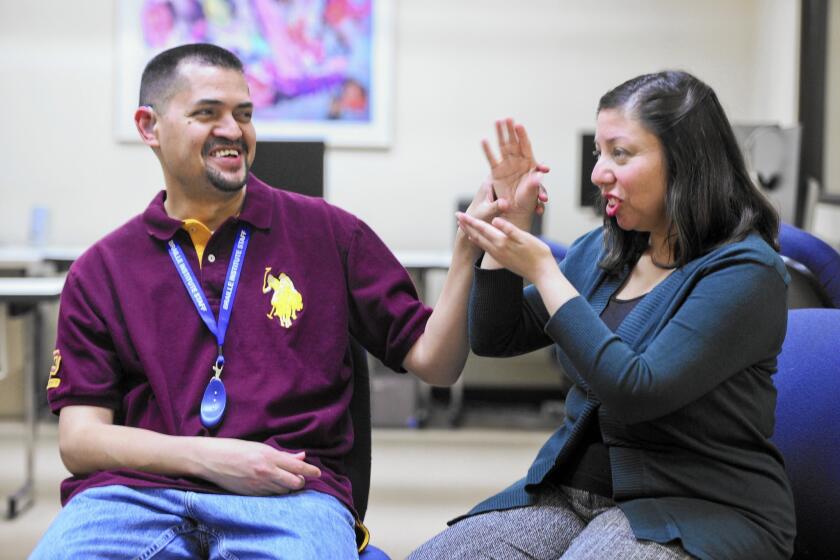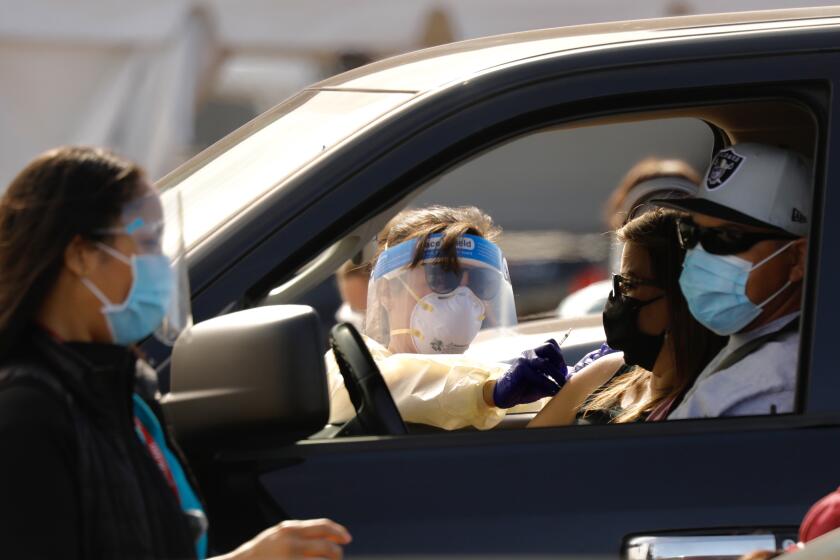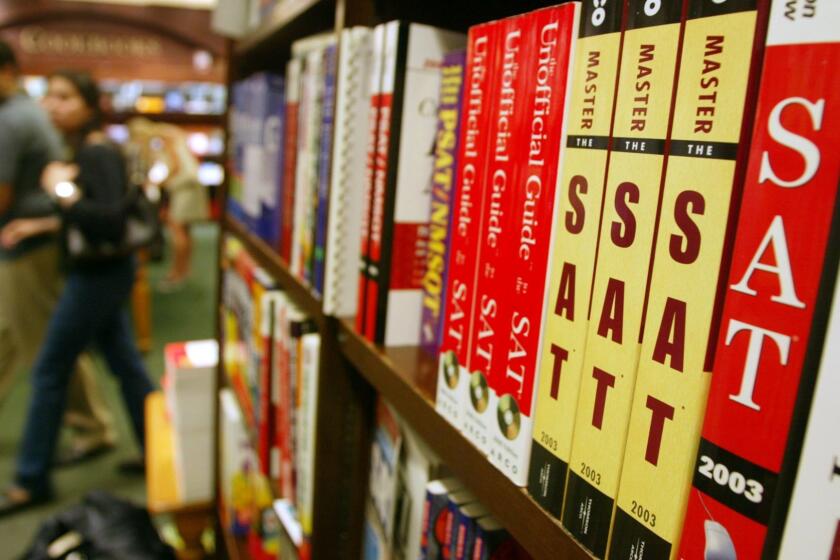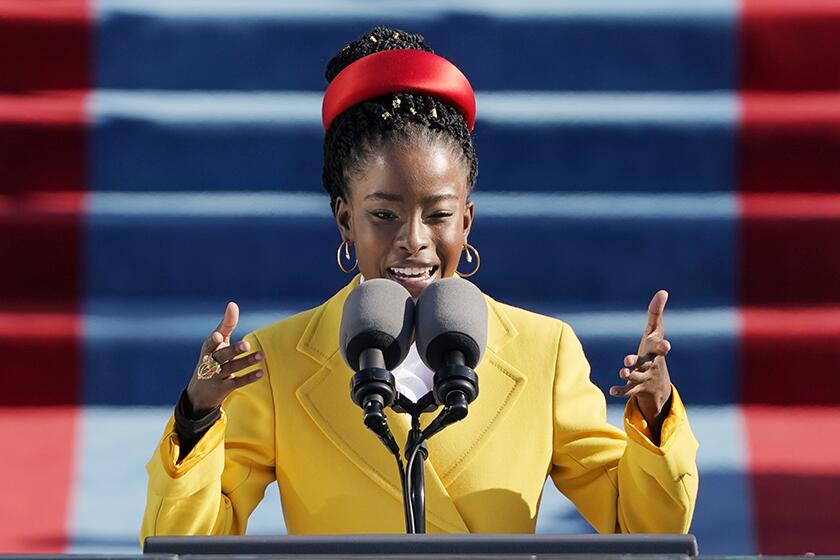Braille is everywhere, but most blind kids can’t read it. A competition hopes to change that
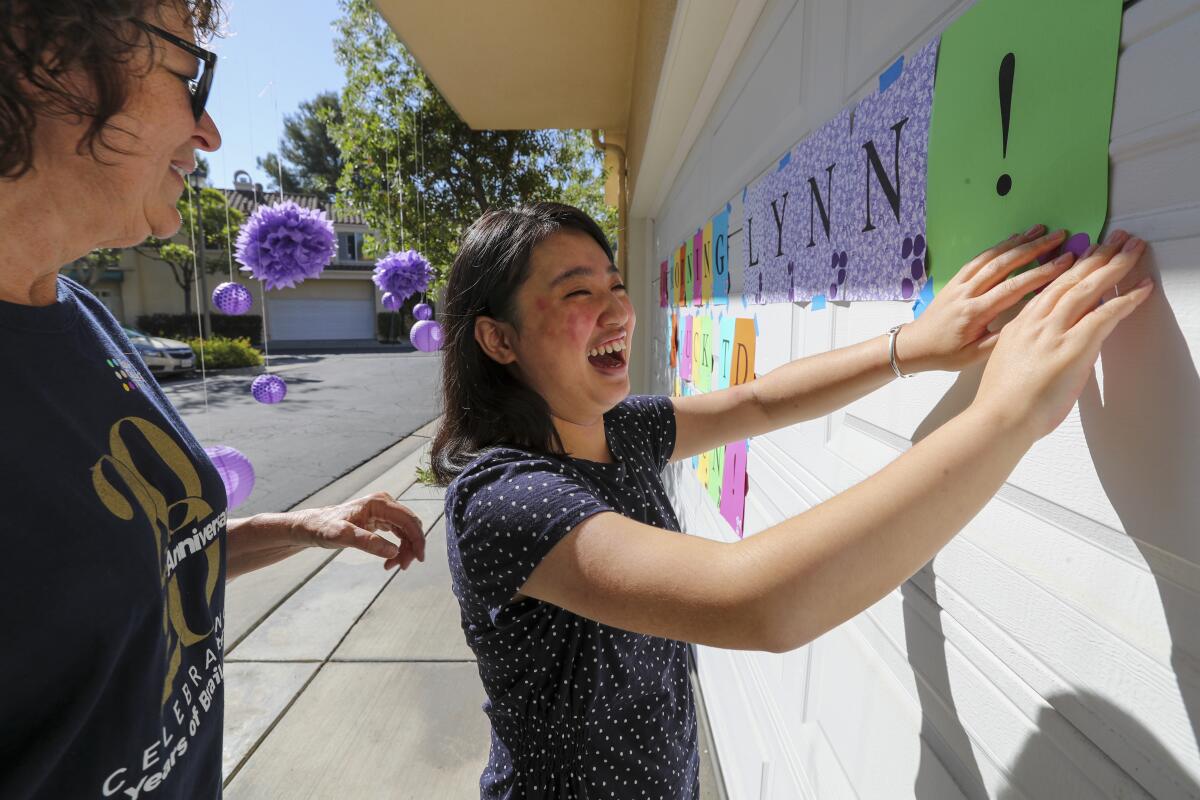
- Share via
The challenger sat alone at a square folding table in the center of her teacher’s immaculate living room, stockinged feet whispering against the plush, white carpet, hands poised over a blue Perkins Brailler — something like a manual typewriter crossed with a court reporter’s steno machine. To say the Brailler is loud is an understatement. The force required to emboss Braille paper produces a noise less like typing and more like repeatedly firing a BB gun.
“It’s really loud,” said contender Lynn Wu, who at the time was a rising freshman at Tesoro High School in Orange County and a finalist in the 20th annual Braille Challenge, a showcase for the most talented blind students in the U.S. and Canada.
The Scripps National Spelling Bee and other name-brand academic competitions were canceled last March due to the pandemic, but Braille Challenge organizers soldiered on, converting the weekend-long championship into 50 individual contests, most of them in July, hosted by proctors in their homes.
This is what brought Lynn to the Laguna Niguel home of her former teacher Rachel Heuser, who had taped a poster to her garage to welcome Lynn to the finals.
“I don’t know if you can see it — there’s dots; those represent the Braille [letters] ‘GD,’ and in Braille, GD is ‘good,’” Lynn explained as she felt her way across the poster.
“Good morning Lynn!” the poster read in 600-point font — and in Braille. “Good luck today and have fun!”
“‘Today’ is ‘TD,’” Lynn continued. “They’re called short-word contractions — those are some simple ones.”
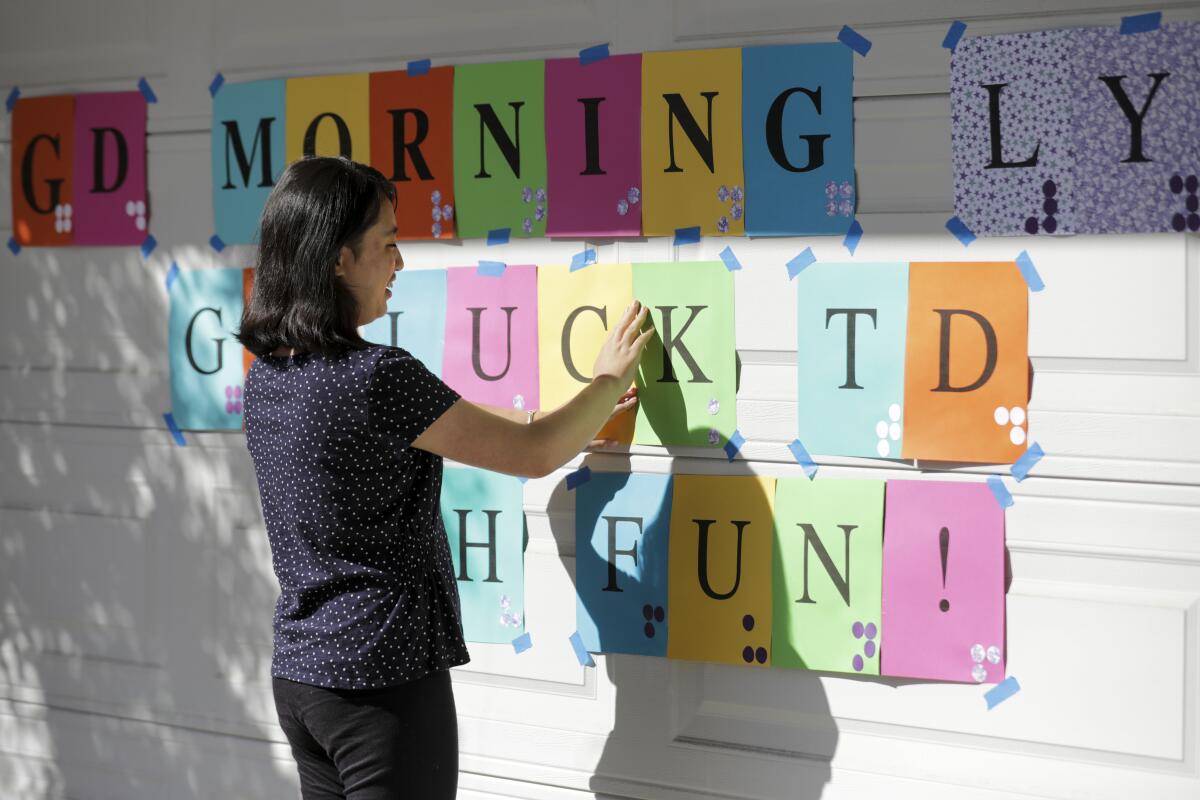
Like the spelling bee, the Braille Challenge is a test of both literacy and willpower. Yet its drama is largely extrinsic: Even if this year’s regionals could be held in public, most observers would find them inscrutable.
A standard qwerty keyboard has 104 keys. A Brailler has nine — six Braille cells, a backspace key and two space bars — which together can encode 26 Latinate letters, 10 Arabic numerals, two dozen Germanic punctuation marks and 200-some word signs and contractions. It can produce seven volumes of Harry Potter, the Five Books of Moses and a 3½-pound copy of “Hamlet.”
“It’s not that hard,” said Lynn, a straight-A student and aspiring lawyer. “When you depend on something, it’s easier to learn it.”
Although the device seems ridiculously analogue, “every single kid learns on a Perkins Brailler,” said professor Yue-Ting Siu, who runs the visual impairments program at San Francisco State. “It speaks to how blind kids’ learning is unique from typically sighted kids.”
It also speaks to when and how blind children entered public schools, and why their long tenure there has failed to produce the same gains achieved by deaf students, autistic students and those with other disabilities.
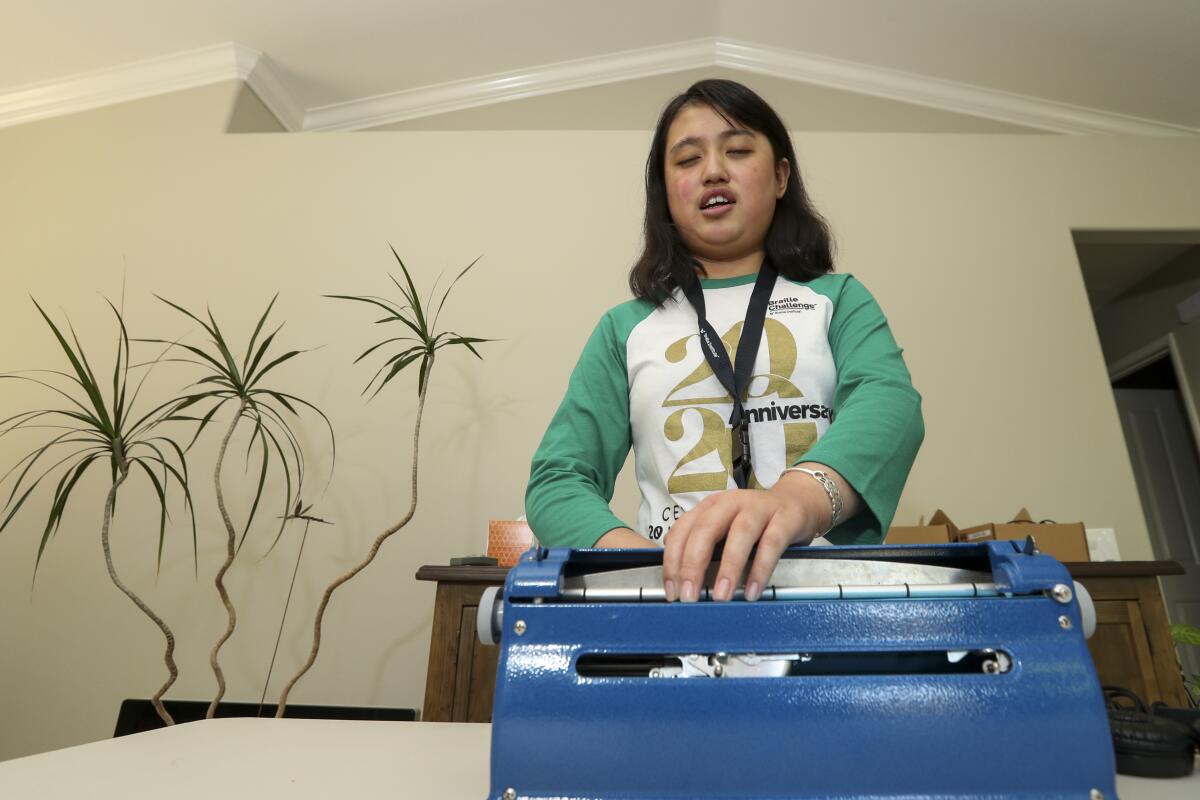
Lynn is 14. The Perkins Brailler is 70. It made its debut in 1951, in the midst of a “blindness epidemic,” caused by oxygen therapy for premature infants, that forced the rapid integration of visually disabled students into American classrooms. By 1960, when the last of this cohort was entering kindergarten, more than half of blind students could read and write tactile script.
Today, fewer than 10% of visually disabled Americans do — perhaps a shock to many sighted people, who see Braille everywhere.
In fact, the Braille dots on parking meters, bathroom signs and ATMs were already illegible to most blind Americans when the Americans with Disabilities Act of 1990 put them there.
Tania and Jose Amaya are both a little shy, but ask them how they met and they’ll light up.
This steep decline in tactile literacy is what spurred the Braille Institute, an L.A.-based nonprofit serving blind and low-vision people, to launch its Braille Challenge in 2000.
“Up until the Braille Challenge, kids simply were not getting enough access to technology for Braille,” Siu said. “Right now, with all the technology that’s available, it’s easier than ever to get Braille under a kid’s fingers.”
Yet blindness remains such a profound disadvantage, it can push even bright, privileged students like Lynn from the top to the bottom of our stratified academic world. Visually disabled students finish high school at less than half the rate of abled children, and even those who earn a bachelor’s degree find work far less often than their sighted peers. In California, only English learners, homeless children and foster youth do worse.
“When I first went blind, I was confused about how school would work,” Lynn said. “With just auditory, you can’t review stuff you learned before, and you can’t read stuff on your own. Math is really hard to do. I’m in honors algebra and trigonometry, and I think it would be impossible” without Braille.
This is the contest’s raison d’être, the reason the Braille Challenge forged ahead with its 2020 finals when other academic championships were canceled. While the hurdles faced by homeless and foster youth are complex, the ones facing blind children are simple. Many experts believe what separates those who succeed from those who struggle isn’t circumstance or even grit — it’s Braille.
“If you compete, it gives you a standpoint, a benchmark for how you compare to other people. At my school, only I use Braille, so I didn’t know if I was fast or not, or if I was proficient or not. I had no one to compare to.”
— Lynn Wu, Tesoro High School student
In 1972, the Supreme Court extended the protections of Brown vs. Board of Education, the landmark school integration ruling, to disabled students. In 1974, Section 504 of the Rehabilitation Act made it illegal for any entity receiving federal funds to exclude any “otherwise qualified individual” because of a disability.
In 1975, the Education for All Handicapped Children Act — now called the Individuals with Disabilities Education Act — gave disabled students the right to learn in public schools. IDEA’s main mechanism of enforcement is a document called an “individualized education plan.”
“I’ve been attending my own IEP meetings since seventh grade,” Lynn said. Officials usually understand her requests for accommodations, “but I don’t know if they have experience with visually impaired students.”
Advocates for some essential workers and people with disabilities express concern that those groups may now have to wait longer to get vaccinated.
Visual disabilities are rare compared with autism, ADHD or dyslexia. Deafness is equally uncommon, yet the law considers American Sign Language just one of several acceptable methods of instruction. Braille, by contrast, is mandated for all visually disabled students, except where such instruction is “inappropriate” — such as for those too young to read, or for those who have concomitant disabilities that make literacy unattainable.
Yet today, only 16% of students who could learn Braille do.
Like many other disabilities, blindness exists on a spectrum: Most people who are considered legally blind can see some light, color and shape, and many find large print accessible. But many others who can technically “see” print either strain painfully to read or lose the ability over time.
Lynn is a good example: Though she was born blind in one eye, she wasn’t introduced to Braille until she lost her sight completely in fourth grade.
“Some teachers think if they can read print, teach them print,” said Arielle Silverman, a disability researcher and consultant, who is blind. “But I’ve met at least two dozen people who say they wish they’d been taught Braille younger. I’ve never met anyone who says, ‘They taught me Braille when I was 5, and I wish they hadn’t.’”
Print and Braille both have their champions, and technology has made both more accessible in recent years. Yet “a significant number” of blind readers — as many as 20% — are never taught either, instead learning entirely through audio media. Multiple experts said they could not imagine a scenario in which audio-only instruction would be considered “appropriate” under the law. But for blind students, the decision depends on a vanishingly small corps of teachers of the visually impaired.
“There’s not a lot of us out there,” said Keith Christian, a Braille Challenge proctor and award-winning teacher of visually impaired students in Orange County, who is blind. “I’m very fortunate in that I have a classroom. Others serve kids on an itinerant basis,” meaning they rove from school to school, sometimes across districts, working with children in mainstream classrooms. “It’s a really big challenge, because we want kids to be assimilated.”
Itinerant teachers were introduced in the 1960s, as part of an ad hoc education program that predates legal integration by a decade. They appeared at a time when blindness was far more common in children than it ever had been or would be again, as part of a system meant to help districts quickly assimilate students who had been excluded for the whole century prior. When Congress created the right to “an individualized and appropriate education” for disabled students, the system for educating blind ones had already ossified around the needs of administrators.
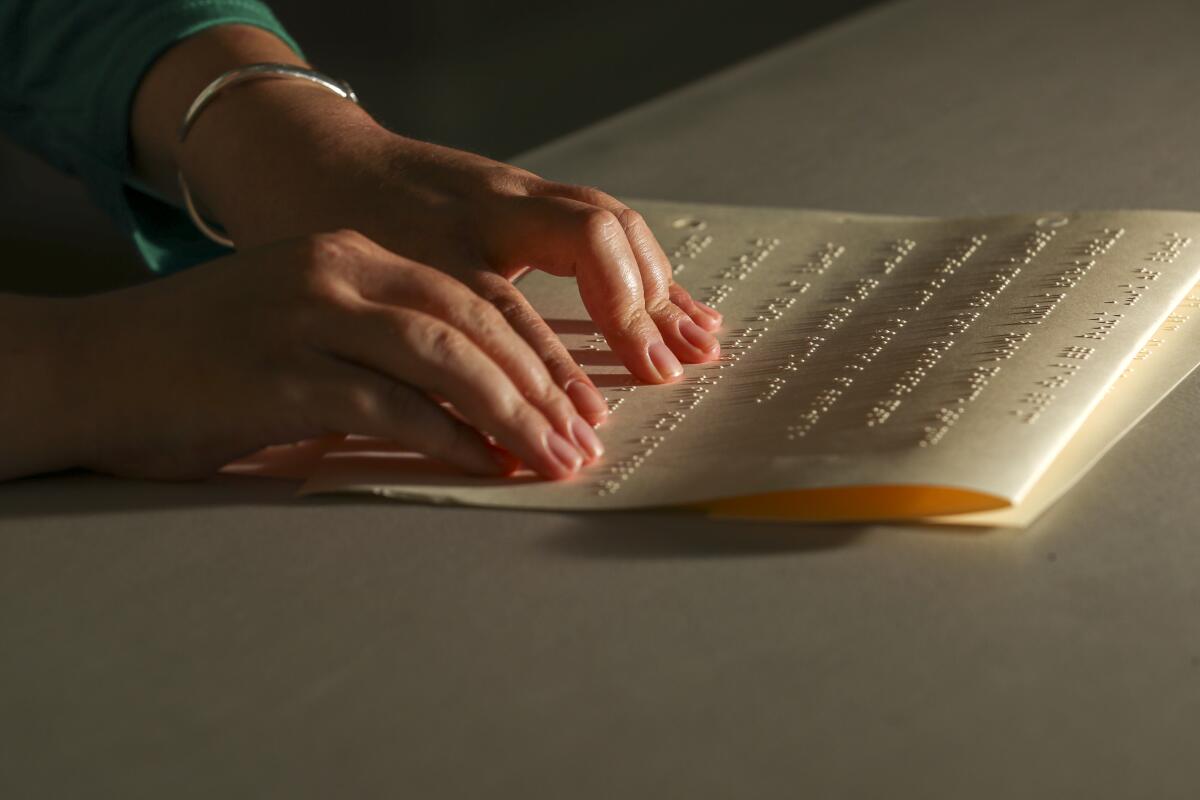
Today, the majority of blind and visually impaired students in California are served by itinerant teachers, some of whom have caseloads almost 10 times the state’s recommended maximum, experts say. Many such teachers are themselves students, working under intern or emergency licenses, sometimes without oversight, often before they have functional literacy in Braille or the training to assess whether their students should learn it. Virtually none are working below double capacity, as defined by California’s revised 2014 standards.
Legally, the teacher shortage shouldn’t affect which format students learn. But functionally, it often does. For those who rely on Braille, the Braille Challenge helps bolster the “free appropriate public education” guaranteed but rarely delivered under the law.
“If you compete, it gives you a standpoint, a benchmark for how you compare to other people,” Lynn said. “At my school, only I use Braille, so I didn’t know if I was fast or not, or if I was proficient or not. I had no one to compare to.”
It was a remarkably adult statement for a girl who celebrated the end of her Braille Challenge exams by rolling in the grass with a guide-dog puppy named Zamboni.
“Is he cute?” Lynn asked her 4-year-old sister Lauren, who squealed with delight when the dog licked her hand. “Did he give you a kiss?”
The Superior Court judge’s ruling came in a case challenging the use of test scores for students with disabilities but will affect all students.
Experts say that attitude is not unusual among Gen Z teens and their families. Though the Braille Challenge is niche by definition, bees, bowls and brain sports are more popular among Zoomers than they’ve been in any previous generation. In a typical year, 11 million middle-schoolers fight for a seat at the Scripps National Spelling Bee, 2.5 million vie for the National Geographic Bee, and at least 100,000 battle through Mathcounts — and those are just the competitions that are televised.
“Some of these kids are in highly ranked, highly resourced schools, and the parents still say the school doesn’t do enough,” said Pawan Dhingra, a professor of American studies at Amherst College and the author of “Hyper Education: Why Good Schools, Good Grades, and Good Behavior Are Not Enough.” “If you don’t trust the school to educate your kid, you have to take it on yourself. Academic competitions become a great venue for that.”
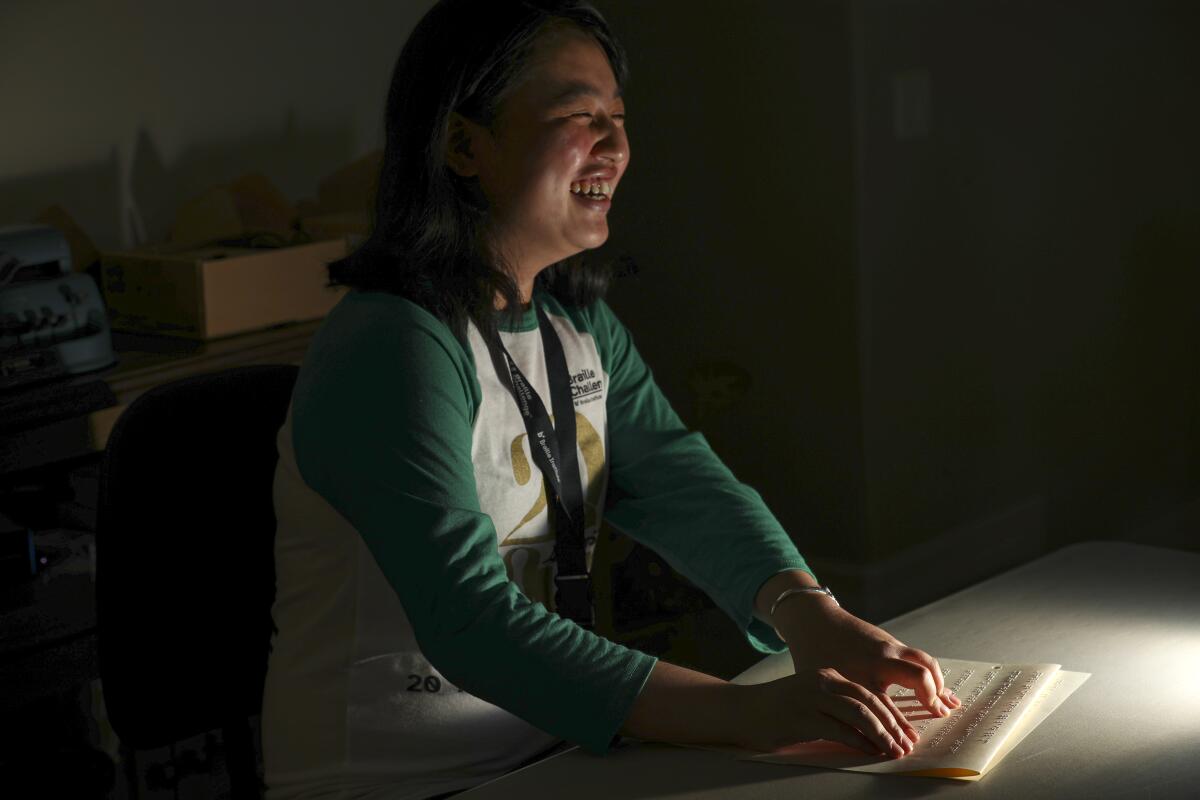
The pandemic appears to have cemented those beliefs, despite the many crushing cancellations in 2020. With a few prominent exceptions, most bees will be back in 2021, following much the same road map the Braille Challenge charted last year when it made its finals remote. The Scripps spelling bee launched its own online testing system, while Mathcounts and other prestige STEM contests have adopted the Art of Problem Solving’s digital competition platform.
“There was a time where I don’t think there was so much social life built around the contest. So in a way it’s a return to that, but in a very different era,” said Shalini Shankar, a professor of anthropology and Asian American studies at Northwestern University and the author of “Beeline: What Spelling Bees Reveal About Generation Z’s New Path to Success.” “I think it’s going to run much more like a pure education contest.”
Braille Challenge regionals are typically an all-day affair, one of few opportunities kids like Lynn have to socialize with visually disabled peers. Friendly rivals from San Diego to Santa Barbara flock to Fullerton to test their skills in speed and accuracy, spelling, proofreading, reading comprehension and charts and graphs. Novices are welcome. The atmosphere tingles with flat Coke and teen nerves and overinflated balloons.
Organizers tried to infuse the Braille Challenge awards ceremony with excitement when it was livestreamed on YouTube. But during the pandemic, without the lukewarm pizza and lifelong friendships to soften it, the whole project seemed suddenly, terribly grown-up.
“Unfortunately, nearly two-thirds of all working-age people with disabilities are not in the labor force,” David D’Arcangelo, head of the Massachusetts Commission for the Blind, told the winners. “I want you to be in the labor force because I believe that leads to more dignity, more independence and more chances at prosperity for you. Your Braille literacy skills put you one step closer down your path to employment.”
The NFL announced Wednesday that Amanda Gorman, L.A.’s celebrated inauguration poet, will recite an original piece at the Super Bowl next month.
When Lynn won third place a few minutes later, there wasn’t even applause. She was one of 10 finalists winnowed down from hundreds of competitors. Yet for her and other Zoomers, the lure of bee season has never been stronger.
“There’s no other contest like it,” Lynn said recently. “It’s a great experience.” She is already taking practice tests for the 2021 regionals, which start this month.
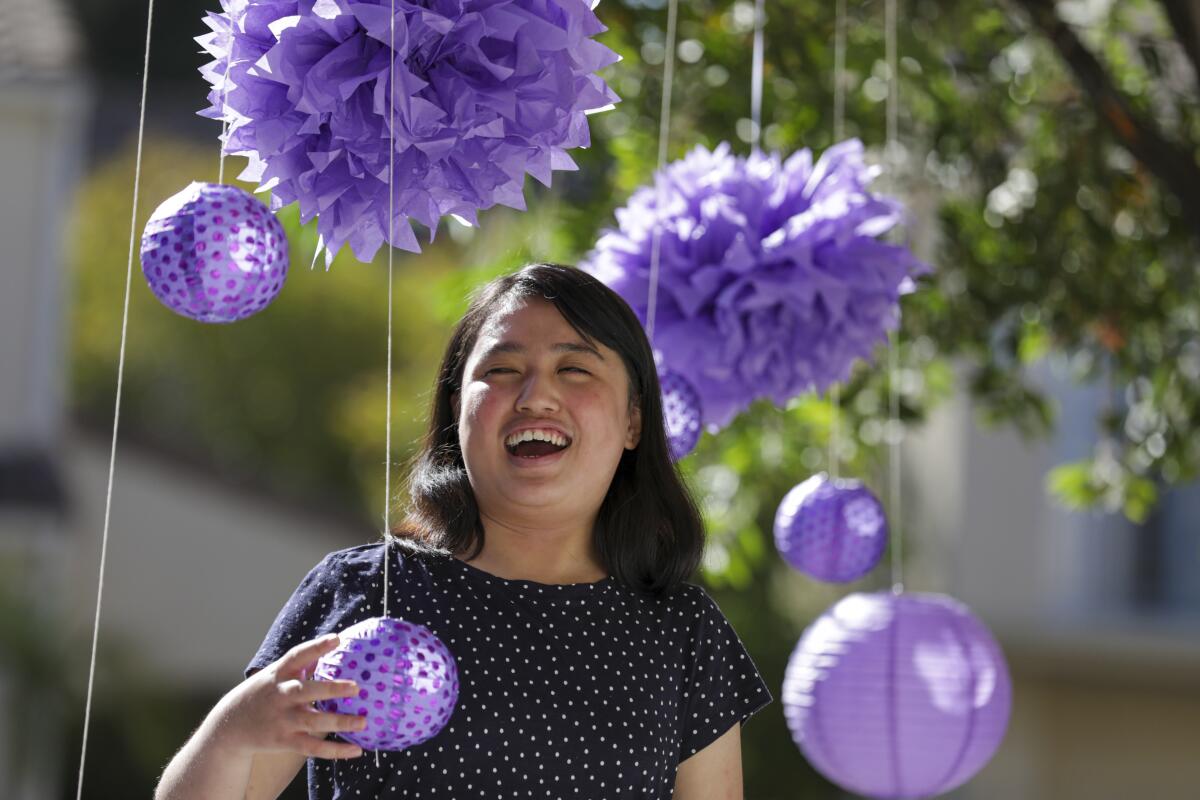
More to Read
Sign up for Essential California
The most important California stories and recommendations in your inbox every morning.
You may occasionally receive promotional content from the Los Angeles Times.

